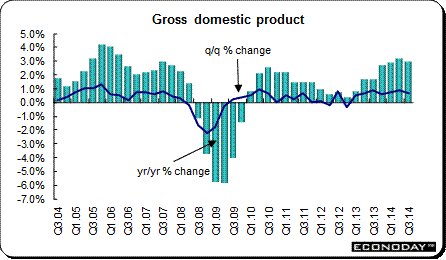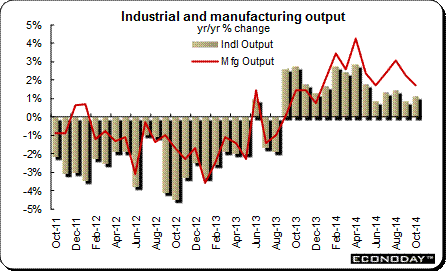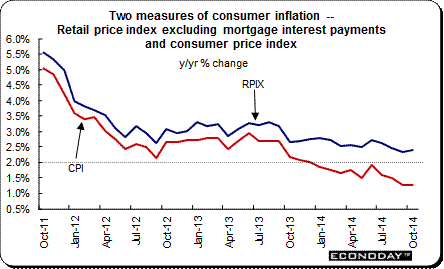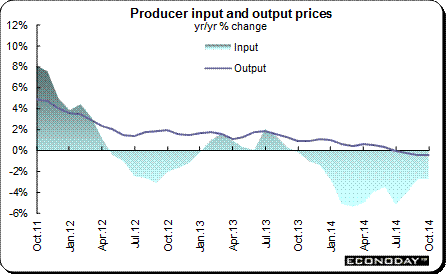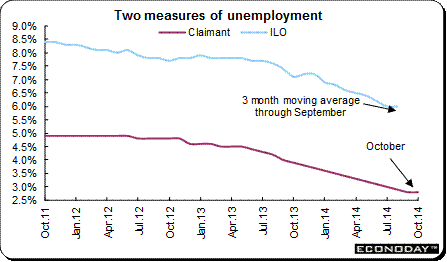
|
Gross Domestic Product— Britain managed to avoid a recession in the early 2000s despite weakness elsewhere in the global economy. At that time, economic growth came from a strong and thriving services sector that more than offset a weak manufacturing sector. One reason for manufacturing's weakness had been the strong value of the pound especially against the euro and the dollar. This made British manufactured products expensive in the Eurozone, the nation's primary export market. As in the U.S., the consumer and housing provided the backbone of growth — until now.
After several quarters of weakening, growth contracted in the second quarter of 2008 as the credit crisis engulfed the important financial sector and the housing sector crumbled. At the same time, inflation — thanks to commodity price increases — limited the Bank of England's actions to stimulate growth by cutting interest rates. GDP shocked analysts and declined for five consecutive quarters before growing again in the third quarter of 2009. GDP contracted once again for three quarters — from the fourth quarter of 2011 through the second of 2012. Third quarter GDP jumped 0.9 percent on the quarter thanks to a boost from the Olympic Games. GDP contracted 0.3 percent in the fourth quarter, threatening yet another recession.
However, the UK dodged another recession — first quarter 2013 GDP was up 0.4 percent on the quarter and up 0.2 percent from a year ago, primarily on stock building. But household consumption was weak, only managing to edge up 0.1 percent while fixed capital investment dropped 0.8 percent. Second quarter GDP surprised and expanded 0.7 percent on the quarter and was up 1.3 percent from the same quarter a year ago. GDP continued to grow in the third quarter gaining 0.8 percent on the quarter and 1.9 percent on the year. Growth eased slightly in the fourth quarter, rising 0.7 percent on the quarter and 2.7 percent from a year ago.
Second quarter 2014 GDP growth was up 0.9 percent on the quarter after increasing 0.7 percent in the first. GDP was up 3.2 percent from a year ago after increasing 2.9 percent in the first quarter. This was the fastest pace of annual growth since the fourth quarter of 2007. Third quarter GDP was up 0.7 percent and 3.0 percent on the year.
Industrial Production — Industrial production was a drag on the economy for some time even though it only accounts for about 16 percent. Initially, British manufactured goods were expensive in its two primary markets — the Eurozone and the U.S. — thanks to a strong currency. But with weak to nonexistent growth in its primary markets and at home, industrial and manufacturing output continues to struggle. The Queen's Jubilee and its extra holiday in June 2012 combined with August's Olympics distorted both industrial and manufacturing output along with many other economic indicators.
October output slipped 0.1 percent on the month while manufacturing declined 0.7 percent. On the year, the former was up 1.1 percent and the latter, 1.7 percent.
Inflation — Inflationary pressures despite the weak economy limited Bank of England policy actions as the CPI remained above the Bank's inflation target of 2 percent. The graph below compares two measures of consumer inflation. The retail price index excluding mortgage interest payments was the Bank of England's inflation measure until January 2004 when it was replaced with the consumer price index. The CPI uses Eurostat's harmonized index of consumer price methodology and is comparable across the European Union. The RPIX has been used for a variety of domestic purposes including cost of living adjustments. With an inflation target of 2.0 percent, the Bank of England continues to be cautious given continuing inflationary pressures. In the last few months of 2013, the CPI eased toward the inflation target — it finally reached it in December when the CPI registered an annual gain of 2.0 percent. The CPI has been below the BoE's inflation target for the first eight months of 2014. In August, the reading was 1.5 percent on the year, in September and October, 1.3 percent.
Producer prices are measured two ways — input prices and output or factory gate prices. Whether input or output, the PPI which had been influenced by higher input prices for raw materials has seen these pressures ease. Now downward sliding prices are a concern.
Unemployment — Two unemployment measures are used to evaluate labor market conditions. The first is the timelier claimant unemployment rate, which increased to 4.9 percent before easing to 4.5 percent in April 2011. This rate climbed again to 4.9 percent where it remained from September 2011 to June 2012. After declining to 4.5 percent in March 2013 it remained there for three months until edging down to 4.4 percent in June and to 4.3 percent in July. The claimant count unemployment rate continued to slide in 2014. It continued to edge downward — August's rate was 2.9 percent and in both September and October, 2.8 percent.
The second unemployment measure is the International Labour Organisation (ILO) unemployment rate, which excludes jobseekers that did any work during the month. The ILO rate is currently 6.0 percent.
Merchandise trade — Ever since statistics on exports and imports of goods were first collected in 1697 trade has been one of the country's key economic indicators. Britain's merchandise trade balance has historically been negative. Like the U.S., Britain must rely on healthy investment income from abroad and service exports to fund its appetite for imported goods. The greatest volume of trade takes place with other EU countries, thus the exchange rate between the pound sterling and the euro plays a crucial role.
|
|||||||
| Legal Notices | ©Copyright 1998-2025 Econoday, Inc. |
powered by
![[Econoday]](images/logo.gif)
![[Apple App Store]](/images/AppleAppStore.png) ![[Econoday on Kindle]](/images/kindle.jpg) 
|
||||||
